|
|
This appendix presents
organizations and duties as follows:
-
Corps and division organizations.
-
Fire support cell organizations.
-
Duties of fire support
personnel.
Organizations of the following
corps and divisions are shown in illustrations in this section:
-
US Army corps.
-
Armored division.
-
Mechanized division.
-
Motorized infantry division.
-
Light infantry division.
-
Air assault division.
-
Airborne division.
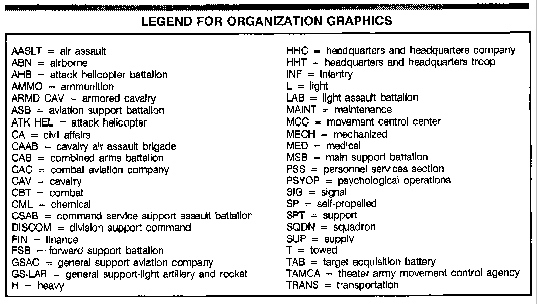
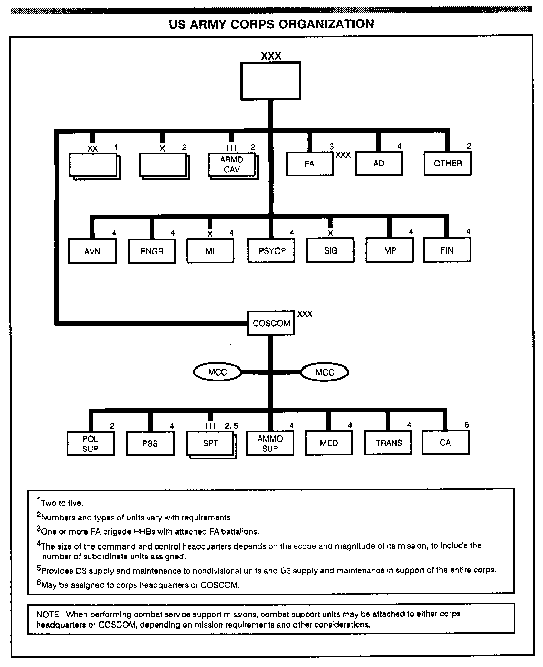

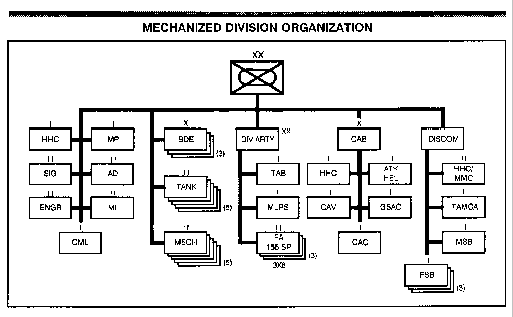
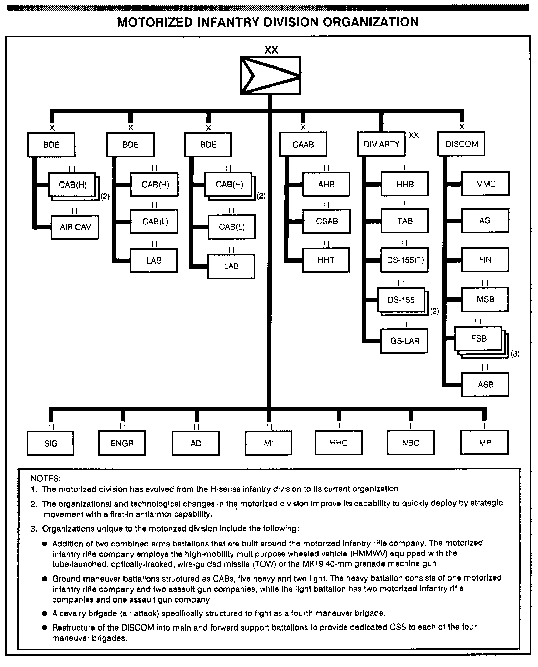
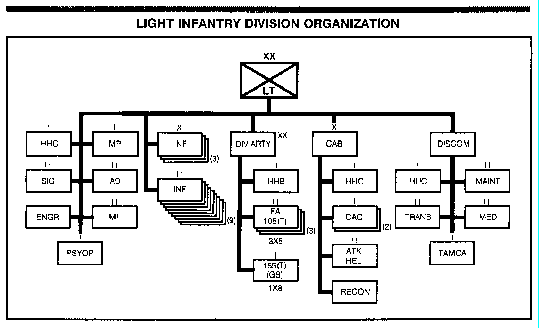
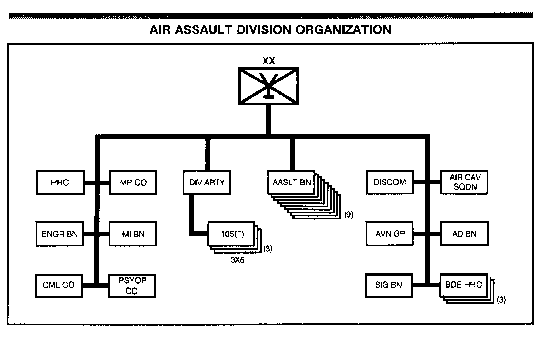
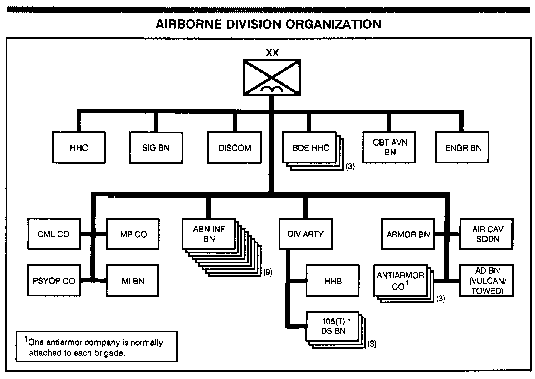
Division command posts are divided into a tactical CP,
a main CP, and a rear CP. Like the command cell,
current
operations cell, and all-source intelligence center (ASIC), the FS cell operates
at the main CP. The field artillery representatives, who comprise
the fire support element, form the nucleus of the FS cell. Other
personnel who may either work in the FS cell habitually or actively
coordinate with it as needed are the G2, G3 air, assistant division
engineer, chemical officer, EW officer, and representatives from
the TACP, AD, division aviation, and ANGLICO. The FSCOORD, or
AFSCOORD in his absence, supervises FS cell activities. These include
planning, coordinating,
and integrating fire support operations, to include TACAIR and EW support.
Detailed breakdowns of the CP organizations are in FM 71-100. The table below
shows the FSE personnel authorized
for different types of divisions.

The tactical CP FSE is responsible
for fire support coordination for the current battle. It is an
austere organization. It coordinates and implements the fire support
from the subordinate brigade FS cells and identifies fire support
requirements for the immediate and near-immediate tactical situations.
Representatives from all fire support resources responsive to
the division collocate with the FSE. The FSE is as mobile as the
supported maneuver force tactical CP.
There is no standard organization
for the tactical CP FSE. The table, Type Division Fire Support Element, shows a possible
division of FA personnel between the tactical CP and the main
FS cell in a heavy division, The figures below show type layouts
of tactical CP FSEs in heavy and light divisions. The heavy division
FSE is in an M577 command post carrier. The light division FSE
is in an HMMWV. Each vehicle should be located near the G3's vehicle
for easy coordination and flow of information.
Normally, the tactical CP
FSE operates in the following TACFIRE and non-TACFIRE nets:
-
Div arty command/intelligence
net (FM-voice) or division command net (FM-voice).
-
Div arty fire direction net
(FM-voice) or div arty operations net 1, 2, or 3 (FM-digital).
-
Div arty command/fire direction
net 2 (SSB-RATT).
-
Command multichannel link
to the main CP FS cell and div arty CP when available.
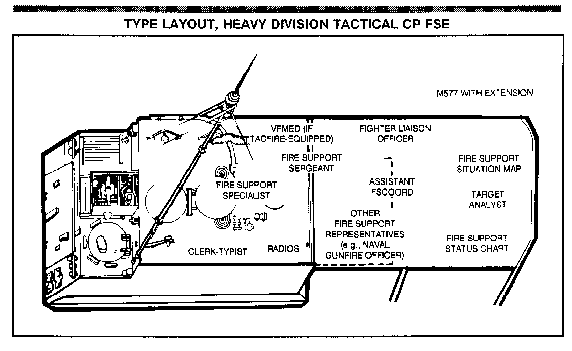
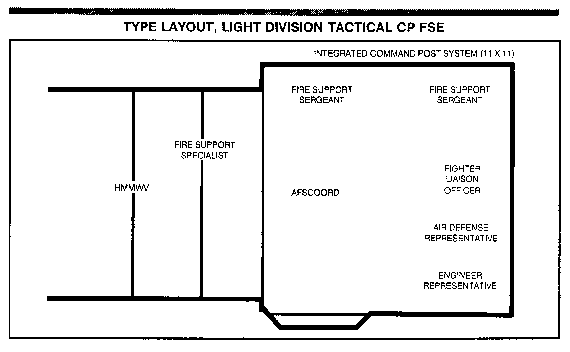
The main FS cell is collocated
with the division main CP. It is responsible for production of
the fire support portions of the division operation plans and
orders. It augments the capabilities of the tactical FSE, when
required. It is the focal point for planning the fire support
portion of the operation plan (OPLAN) for extended operations.
There is no standard organization
for the main CP FS cell. The table, Type Division Fire Support Element, shows a notional
division of personnel between the tactical CP and main CP FS cells
in the heavy division. The figures below show type layouts of
a heavy division main CP FS cell in an expansible van and a light
division main CP FS cell in a HMMWV.
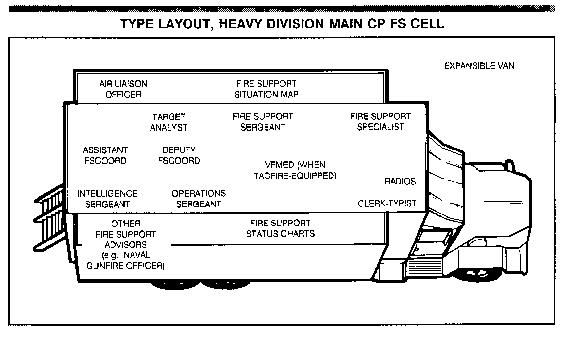
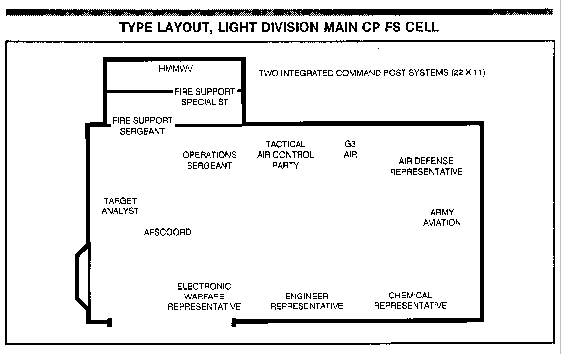
In addition to the operations
and plans cells, the FS cell works closely with the A2C2 element. The A2C2 element manages airspace over
the division sector with emphasis on the area between the brigade
rear boundaries and the division rear boundary. It helps the tactical
FS cell coordinate those activities associated with current combat
operations but beyond the capabilities of the tactical CP FSE.
The FS cell must keep the A2C2 element informed and must
coordinate fire support use of airspace for planned operations.
Both the division and corps
commanders synchronize close, deep, and rear operations through
a coordinated effort at the main CP. To help them in this function,
specific staff elements are tasked to gather and provide information
to the commander as required.
Battle coordination functions
may include the following:
-
Acquire and identify high-payoff
targets.
-
Assess attacks.
-
Adjust assets.
-
Change battle plans.
-
React quickly to high-priority
targets.
-
Recommend targets.
- Use target value analysis to identify target priorities.
-
Determine fire support needs.
-
Expedite fire support.
-
Assess fire support effects.
-
Coordinate timing of fire
support attacks (to include EW).
-
Recommend use of TACAIR assets.
Normally, the main CP FSE
operates in the following TACFIRE and non-TACFIRE nets:
-
Div arty command/intelligence
net (FM-voice) or div arty command net (FM).
-
Div arty fire direction net
(FM-voice) or the designated div arty operations net 1, 2, or
3 (FM-digital). The radio identified for this use may be used
to operate in the division command/operations net.
-
Div arty command/fire direction
net 2 (SSB-RATT).
-
Multichannel link to the tactical
CP FSE and div arty CP when available.
The FS cell operates within
the guidance and policies established by the division commander
to direct the use of the fire support resources available to the
division.
The division rear CP coordinates
sustainment of current operations, plans for future operations,
terrain management of all units currently residing or moving into
the division rear, and base cluster security plans and rear operations.
The rear CP FSE, one fire support officer and two fire support
sergeants, operates in the rear operations cell. These individuals
are reflected on the division rear tactical operations center
(TOC) TOE (standard requirement code [SRC] 87103L000). Rear CP
manning will come from the US Army Reserve Component.
The corps commander, like
the division commander, organizes tactical, main, and rear CPs.
The table below shows a possible distribution of field artillery
personnel in the corps fire support element.
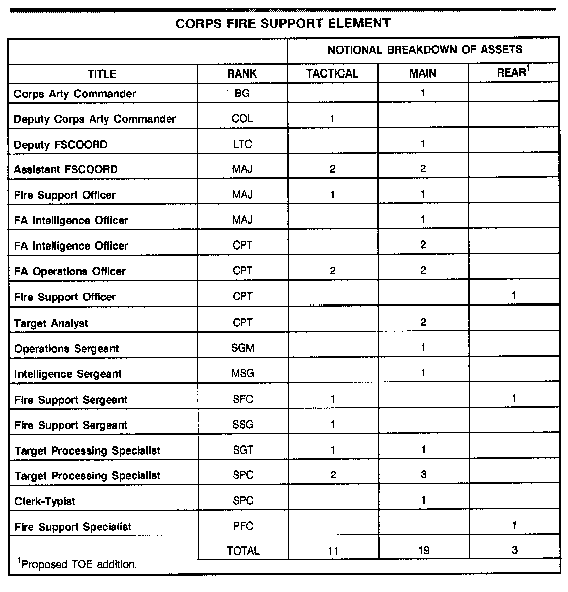
Because of the organization
of the corps FS cell, the manning of the tactical CP FSE must
be minimal. The figure below shows a type layout of a corps tactical
CP FSE. The M577 shown must be provided by the corps head-quarters
and headquarters company (HHC), or it may be organic to the corps
artillery headquarters battery. The VFMED authorized for the tactical
CP FSE may be mounted either in the M881 1 l/2-ton vehicle organic
to the fire support element or in the M577.
The tactical CP FSE can communicate
with the corps artillery CP over an FM net. They use the RATT
(SSB) capability deployed with the corps CP for communication
with the main FS cell, when necessary. They also use multichannel
communication, to include multiple subscriber equipment, if available,
to communicate with the main CP FS cell.
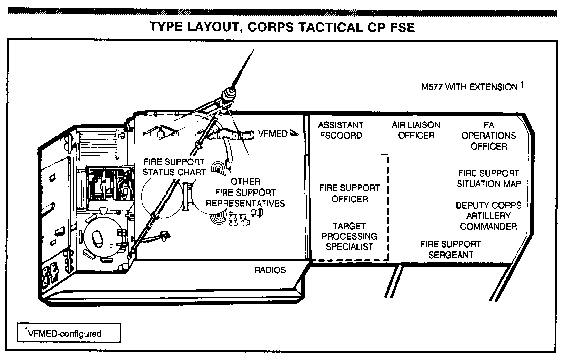
The main FS cell is collocated
with the corps main CP and must be close to the G2 and G3 elements
to be effective in fire support planning. The main FS cell is
concerned primarily with planning future operations and with fighting
deep operations. The figure below shows a type layout for the
corps main CP FS cell.
The FS cell members serve
with the corps staff in targeting efforts similar to those described
earlier for the division level. The Lance liaison element is usually
located at the main FS cell.
The primary means of communication
for the main FS cell is the corps common-user multichannel system.
This provides secure access to all coordinating elements. Also,
the main FS cell has an AN/VRC-46 radio set. This radio is used
for FM communication with the corps artillery commander and the
tactical CP when it is within radio range. The available communications
means are discussed below.
Corps Artillery Command/Fire
Direction Net (SSB-RATT).
The main FS cell communicates over the corps artillery CF net
(SSB-RATT) to coordinate nuclear fire support and to link the
FS cell with field artillery retained under corps control.
Corps Artillery Command/Operations
Net (SSB-Voice). The
Lance battalion commander and operations element operate in this
net with the corps artillery HHB operations/ intelligence section.
The net is used for tactical and administrative control; for coordinating
and requesting fire support; and for collecting, exchanging, and
disseminating intelligence information.
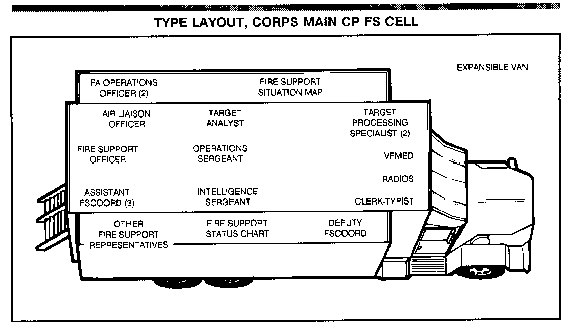
Corps Artillery Fire Direction
Net (SSB-RATT). This
net provides radioteletype communication between the corps artillery
and corps main CP FS cell, the ACR, separate maneuver brigades,
and each div arty within the corps. It is used for requesting
additional fire support and for coordinating artillery fire support,
both nuclear and nonnuclear.
Corps Mobile Subscriber
Equipment System. The
main FS cell has common-user access to the entire corps MSE communications
system. The corps MSE system is interconnected with automatic
switching equipment, which has converted the MSE system into a
virtually 100 percent common-user system. Sole-user circuits are
provided only as an exception. They require close coordination
with the corps signal brigade. TACFIRE is not compatible with
the automatic switches as designed. However, TACFIRE can work
through the automatic switching system if it is given a priority
high enough to prevent preemption and if it is allowed to seize
a circuit in the switches. Because of limited multichannel assets
and the corps artillery HHB requirements for common-user and sole-user
circuits, close coordination must take place between the corps
artillery signal officer and the corps signal brigade to ensure
that adequate MSE assets are provided. This is also true for the
division MSE system to a lesser extent, since the division is
not as dependent on MSE communications. Detailed coordination
with the division signal officer (DSO) is still a must.
Fire Support Cell
Automation.
The capabilities of the corps
artillery TACFIRE are similar to those of the TACFIRE at division
level. The corps FS cell is the focal point for preparation of
the nuclear package. The VFMED in the main FS cell is an excellent
tool for preparing interdiction attack options to support interdiction
planning. Targets may be developed in the corps main CP or submitted
by subordinate units as requests for additional fire support.
The main FS cell uses the preliminary target analysis program
to identify appropriate attack resources to engage these targets.
The rear CP conducts rear
operations. This function entails command and control of rear
security operations, terrain management within the corps rear
area, sustainment, control of administrative moves, and other
associated functions. The rear CP FSE - one FA captain, a fire
support sergeant, and a driver - operates from the rear operations
cell. These individuals are reflected on the corps rear TOC TOE
(SRC 52403 L000). Rear CP manning will come from the US Army Reserve
Component.
The field artillery commander
at corps or division is designated the FSCOORD. He is the force
commander's primary advisor on fire support matters. He maintains
a good working relationship with the commander, operations officer
(G3), and ALO throughout the planning and execution phases of
the operation. The FSCOORD must be thoroughly familiar with the
battle plan so that he can anticipate missions, situations, and
changes and then advise the force commander on the best use of
fire support. The FSCOORD's primary responsibilities (at corps
or division level) are as follows:
-
Establish and supervise the
activities of the FS cell.
-
Plan and synchronize fire
support.
-
prepare the fire support portion
of the corps or division operation plans and orders.
-
Advise and inform on all fire
support missions.
The corps FSE is organized with the deputy corps artillery commander serving as the DFSCOORD and enough assistant FSCOORDs (AFSCOORDs) to work in the tactical and main CPs on a shift basis. Each division is organized with the DFSCOORD (05) and enough AFSCOORDs to work two shifts in the main and tactical CPs.
The duties of the corps DFSCOORD
are as follows:
-
Supervise the operation of
either the main FS cell or the tactical CP fire support element.
-
Recommend fire support coordinating
measures to the corps commander or his representative as the battle
progresses.
-
Keep close contact with the
main FS cell or tactical CP fire support element to keep them
informed of current operations and the immediate fire support
needs of the forces.
-
Recommend changes to the field
artillery organization for combat as necessary to support current
and future operations.
The duties of the FSO at the
tactical CP are as follows:
-
Maintain the current status
and capabilities of available fire support resources.
-
Supervise the FSE Operation
in the absence of the AFSCOORD.
-
Maintain the fire support
situation map.
The duties of the AFSCOORD
in the FS cell in the corps main CP are as follows:
-
Supervise the operations of
the main CP FS cell.
-
Control and supervise toxic
chemical and nuclear weapons package planning and employment within
the corps.
-
Refine nuclear aimpoints in
the corps package.
-
Recommend the use of fire
support coordinating measures after coordination with the air
liaison officer.
-
Supervise preparation of the
fire support plan for future operations.
-
Resolve conflicts and duplications
among the various fire support systems.
- Advise fire support liaison representatives present.
-
Coordinate fire support for
deep operations.
The AFSCOORD is assisted by
the FSO in the corps main CP FS cell. The duties of the FSO are
as follows:
-
Maintain the current status
and capabilities of all fire support resources available to the
corps.
-
Maintain the fire support
situation map.
-
Develop the fire support plan
for future operations.
-
In conjunction with the G2
air, the G3 air, and the air liaison officer, formulate the SEAD
plan for the corps.
-
Perform the duties of the
AFSCOORD in his absence.
The FA plans officer and fire
support sergeant represent the FSCOORD at the corps rear CP. Their
duties are as follows:
-
Collate base, base cluster,
and response force fire support plans received from subordinate
rear area operations centers into a composite rear operations
fire support plan.
-
Integrate fire support provided
by territorial forces into the rear operations fire support plan.
-
Coordinate the rear operations
fire support plan with the corps FSCOORD and the TCF.
-
Coordinate with the FS cell
at the main CP for fire support for response forces.
-
Coordinate fires in support
of response forces and the TCF.
-
Review requests for CAS from
response forces or the TCF, and forward the request to the FS
cell at the main CP.
The duties of the division
deputy FSCOORD are as follows:
-
Serve as the full-time representative
of the FSCOORD to the force commander and his staff.
-
Position himself where he
can provide the greatest assistance (in either the tactical or
main CP).
-
Help integrate fire support
into the battle plan.
-
Supervise the tactical FSE
and the main FS cell.
-
Recommend allocation of fire
support and field artillery organization for combat.
-
Recommend fire support coordinating
measures.
-
Advise the division commander
and his staff on fire support matters.
The duties of the division
AFSCOORD follows:
-
Serve as the full-time representative of the FSCOORD in the main
FS cell or the tactical CP fire support element.
-
Supervise the operation of
the main FS cell.
-
Plan and coordinate all means
of fire support.
-
Advise the maneuver commander
and his staff on all fire support matters.
-
Supervise preparation of the
interdiction plan for fire support.
-
Assign target numbers to by
the main CP or FS cell.
-
Maintain the fire support
targets developed status, and report to the
supported maneuver commander and his staff as necessary.
-
Receive, coordinate, and forward
fire support requests from subordinate units.
-
Ensure organic or attached
nuclear-capable units are correctly positioned.
-
Recommend the prescribed nuclear
load (PNL) and prescribed chemical load (PCL) for division units.
-
Supervise preparation of the
division nuclear subpackage recommendation.
-
Recommend fire support coordinating
measures.
- Coordinate with the A2C2 element to provide the corps main FS cell data for establishment of minimum risk routes (MRRs) for aircraft. Coordinate the division fire support plan with adjacent divisions and corps FS cells.
-
Advise other fire support
representatives, and resolve conflicts and duplication among fire
support asset systems.
-
Coordinate the field artillery
portion of fire support plans with the div arty CP.
-
Send fire orders to the div
arty CP when necessary.
-
Pass the maneuver commander's
guidance on target attack priorities and allocation of fires to
other fire support representatives and to the div arty CP.
The FSO represents the FSCOORD
at the division rear CP. The duties of the FSO are as follows:
-
Collate base, base cluster,
and response force fire support plans into a composite rear operations
fire support plan.
-
Coordinate the rear operations
fire support plan with the division FSCOORD and the TCF.
-
Coordinate with the FS cell
at the main CP for fire support for bases or base clusters and/or
response forces.
-
Review requests for CAS from
response forces or the TCF, and forward the request to the FS
cell at the main CP.
| NOTE: The following paragraphs outline the general duties and responsibilities of the key fire support personnel at corps and division. In most cases, the duties are similar at both echelons. |
The duties of the FAIO are
as follows:
-
Serve as FS cell representative
in the all-source production center.
-
Inform the ASPC of fire support
intelligence requirements; for example, high-payoff targets and
indicators.
-
Screen and segregate combat
information, weather, and intelligence in the ASPC for use in
fire support targeting.
-
Pass targets developed by
the ASPC to the FS cell.
-
Coordinate cueing of target
acquisition resources under ASPC control with the FS cell.
-
Advise the ASPC on fire support
and target acquisition matters.
The duties of the target analyst
are as follows:
-
Analyze targets for possible
engagement by nuclear and toxic chemical weapons, as directed
by the AFSCOORD.
-
Plan interdiction targets
for attack by conventional, nuclear, and chemical fires or weapons.
-
Perform detailed nuclear target
analysis and aimpoint refinement as part of the nuclear planning
effort.
-
Provide technical expertise
regarding limiting requirements, troop safety, collateral damage
preclusion, and effects of nuclear weapons.
-
Coordinate chemical planning
with the corps or division chemical officer.
The ALO is a member of the
TACP at each appropriate echelon of command. His duties are as
follows:
-
Provide expertise, help request
and monitor requests for immediate CAS, and process nominations
for BAI.
-
Work closely with the AFSCOORD
to determine where air-delivered systems can be used to the best
advantage, and provide information on the requirements for SEAD
fires.
-
Keep the AFSCOORD and the
G3 informed of the current status of air support assets.
-
Provide communications means
to enter the air request net (USAF).
The assistant AD operations
officer comes from the corps or division Army airspace command
and control element. He serves as the A2C2
representative in the FS cell.
The NGO acts as the liaison
officer for the naval task force supporting the division. He coordinates
all naval gunfire that is supporting the division or that may
affect division operations. He advises the AFSCOORD on all matters
pertaining to naval gunfire employment. These matters include
capabilities, limitations, status of fire support ships, and targets
suitable for NGF engagement.
The duties of the operations
sergeant at corps and division are as follows:
-
Help maintain 24-hour operations
in the FS cell.
-
Supervise the installation
of operations equipment and communications in the FS cell.
-
Supervise the enlisted personnel
in the FS cell, and process administrative matters pertaining
to the FS cell.
- Help the AFSCOORD prepare fire support documents.
-
Supervise the posting and
maintenance of all FS cell charts and records.
-
Prepare required reports in
accordance with local directives.
-
Maintain classified files.
-
Assemble and disseminate the
priority information requirements and information requirements.
The duties of the fire support
sergeant are as follows:
-
Serve as primary assistant
to the AFSCOORD in coordinating fire support.
- Help the target analyst in interdiction planning.
-
Supervise the fire support
specialists.
-
Maintain and update fire support
status charts and situation maps.
-
Perform the duties of the
operations sergeant in his absence.
-
Maintain the staff journal.
The duties of the fire support
specialist are as follows:
-
Work under the guidance of
the fire support sergeant.
-
Help operate and maintain
section equipment, to include computer equipment.
-
Help in fire support planning
and coordination.
-
Operate and maintain communications
equipment.
-
Prepare and maintain a situation
map.
-
Prepare and post daily staff
journals and reports.
-
Help establish, operate, and
displace the FS cell equipment.
The duties of the target processing
specialist (SGT) are as follows:
-
Maintain target acquisition
plan (TAP).
-
Analyze targets on TAP for
possible engagement by nuclear and toxic chemical weapons, as
directed by the target analyst.
-
Plan interdiction targets
on TAP for attack by conventional, nuclear, and chemical fires
or weapons.
-
Help provide technical expertise
regarding limiting requirements, troop safety, collateral damage
preclusion and effects of nuclear weapons.
-
Help perform detailed nuclear
target analysis and aimpoint refinement as part of the nuclear
planning effort.
-
Supervise the posting of targets
on the targeting overlay.
-
Supervise and maintain the
relative value matrix chart.
-
Supervise training of the
section on target log, target cards, relative value matrix chart,
and spread sheet.
-
Perform duties as required
by the target analyst.
-
Perform duties of the fire
support sergeant in his absence.
-
Be knowledgeable of the Threat
force equipment and tactics.
The duties of the target processing
specialist (SPC) are as follows:
-
Log all targets from sources
(for example, FAIO, division FS cell, brigade operations, and
TACFIRE).
-
Maintain the relative value
chart.
- Help post targets on the targeting overlay.
-
Fill out and maintain target
cards.
-
Help the target analyst prepare
spread sheets and briefing materials.
-
Maintain necessary references.
-
Perform duties as required
by the target analyst.
-
Perform duties of the target
processing specialist (SGT) in his absence.
-
Be knowledgeable of the Threat
force equipment and tactics.
|
NEWSLETTER
|
| Join the GlobalSecurity.org mailing list |
|
|
|

